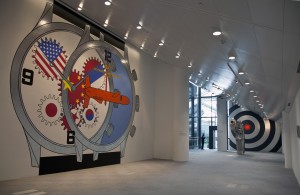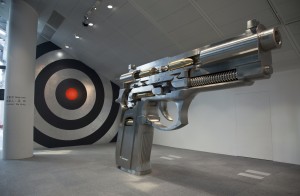Exploring All of Life’s Paradoxes
By SHEILA MELVIN
BEIJING — “Diagramming Allegory,” the Wang Luyan solo exhibition at the Beijing Parkview Green Exhibition Hall, occupies an enormous space divided into two long galleries. While one is configured to resemble a shooting range — with a giant brushed stainless steel handgun, far taller than any man, and an oversize target — the other resembles the nave of a cathedral, including a crucifix and a confessional.
At first glance the two galleries, covering 43,000 square feet, or 4,000 square meters — and the art within — appear diametrically opposed. In addition to the handgun, the first holds works like “Symmetry of Violence” (2008), an acrylic painting of fighting men. The second includes Mr. Wang’s versions of iconic religious masterpieces like Michelangelo’s “Creation of Adam” and Leonardo’s “Madonna Litta,” displayed near a 20-foot high architectural painting of the interior of a church.
Closer inspection, however, reveals a common theme. The giant handgun, “W Fire at Both Ends Automatic Handgun,” is designed so that one pull of the trigger would shoot two bullets in opposite directions, killing the killer even as he kills. Likewise, the men in “Symmetry” are so intertwined that it is impossible to distinguish the perpetrator from the victim. In similar fashion, the figures in the European Renaissance works are painted as though constructed of flat, machine-like parts with jagged, saw-tooth edges, subverting the divine creation and maternal love of the originals into a cold and cruel postindustrial reality. Even the architecture of the painted church is saw-toothed, the tiled floors and vaulted ceiling as redolent of torture as succor.
“Wang works around paradox,” explained Wu Hung, the University of Chicago professor who curated the show, which was scheduled to close in June but has been extended indefinitely. “It can be very political and refer to war. It can be about religion, philosophy, or political commentary. He doesn’t belong to any trends — this kind of conceptualism is very special. His is an untold story in Chinese art.”
Meg Maggio, the director of the Pekin Fine Arts gallery in Beijing who recently presented Mr. Wang’s work at a Hong Kong exhibition titled “Double-Think,” echoed this view.
“He’s an unsung hero of Chinese contemporary art, a strong conceptual artist who hasn’t been pandering to the marketplace,” she said. “He’s been very true to himself and very committed to the process.”
Although Mr. Wang is less well known than other Chinese artists of his generation like Ai Weiwei, he has been involved in Chinese contemporary art since its inception. “He has a very long track record — one of the longest,” said Mr. Wu. “He started in the late 1970s, just after the Cultural Revolution.”
Indeed, Mr. Wang was a member of the groundbreaking “Stars Group,” an art collective that experimented with Western, avant-garde art styles and pushed for artistic freedom. Barred from China’s museums and galleries, which were then filled with socialist-realist art, the group staged a now legendary exhibition outside the gates of the National Art Museum of China (then called the China Arts Gallery) in 1979.
Mr. Wang went on to become one of the three members of the “New Measurement” group (with Gu Dexin and Chen Shaoping), which was a major force in the avant-garde movement of the 1980s and 1990s, and part of the path-breaking “China Avant-Garde” exhibition at the National Art Museum in 1989. The show featured works by 300 artists and it was the first time avant-garde art had been permitted in a museum, but it was shut down near the end of the first day when two artists fired a gun at their own installation.
Many of the artists who participated in these seminal exhibitions went on to enroll in China’s renowned arts academies and became members of the artistic establishment, but Mr. Wang was not among them. “Back then, if you were someone who loved art but had no chance of testing into an arts academy, your only choice was to enter an ‘Amateur Arts Training Course,”’ he explained.
He thus enrolled in amateur drawing classes at the Workers’ Cultural Palace while holding down a day job, working first as a lathe operator at the Beijing Furnace Factory and then as mastheads editor for China Communications News. Eventually he stopped taking art classes because he came to believe they did more harm than good.
“I realized that kind of art ‘training’ is actually a poison to artistic enlightenment,” he said. “In fact, the majority of people who go through it are harmed, and unlikely ever to become independent-thinking and creative artists.”
Mr. Wang largely shunned the Chinese art world during what he calls the “post-colonial” commercial frenzy of the late 1990s and 2000s, when Western critics, curators, museums and collectors descended on Beijing and local artists lined up to meet them. While many artists got rich overnight — Mr. Wang recalls one acquaintance who arrived in Beijing in 2005 unable even to pay rent and several years later was a millionaire — he used the time to sketch, read, ponder and paint.
“I never considered being an artist from the perspective of choosing a career,” he explained. “Whether I was an artist or not, I was always going to paint.”
It was while working at the Beijing Furnace Factory, making metal parts according to design images, that Mr. Wang first became interested in the artistic possibilities of paradox.
“Industrialized production, and modern society, are full of rational rules,” he said. “If you don’t have rules in a factory, the products produced will be useless, and if you don’t have them in society, there will be chaos. But, as science and technology continue to progress and society to develop, there are ever more rules which increasingly conflict with human personality.”
Mr. Wang began sketching his concept of this paradox, starting in 1990 with a simple drawing of a horizontal line wrapped by a red thread that is simultaneously pulling up and down. This concept — of one action resulting in two contradictory reactions — became the primary theory of his work.
“I value paradox because it is the basic mode of existence for human society,” he said.
For many years, Mr. Wang’s focus was on mechanical manifestations of paradox like guns, tanks, screws or bicycles whose intended purpose was subverted or negated. His wristwatches, branded W, are a series of bold, bright and provocative acrylic paintings. The “W Six Party Wrist Watch,” for example, has gears painted with the flags of the countries in the six-party talks on North Korea’s nuclear development; the movement of any of the interlocked gears will cause the others to turn, just as an action by any one of the nations would elicit a reaction from the others.
The “W Birdcage Switch” depicts a bald eagle, a symbol of freedom, in a cage with a complicated series of ropes and pulleys that, if used, would simultaneously open and close the door. (The ropes are red, evoking the red string that Mr. Wang drew around that single line back in 1990.) The artist’s more recent exploration of the contradictions inherent in religious faith is similarly grounded in his conviction that “disbelief is also a form of faith.”
Mr. Wang, who finally quit his day job in 2005, has had solo exhibitions each year since 2007 and his work, according to Ms. Maggio, is in increasingly high demand among collectors in China. But he continues to work at his own pace and to guard his hard-earned independence.
“What’s important is to persist and carry on,” he said. “The more you do this, the deeper your explorations — and the greater the possibility for you to discover and create.”
–
This story was first published in The International New York Times



Leave a Reply